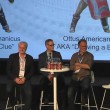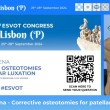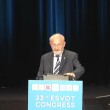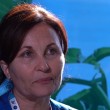
Jonathan Dyce MA VetMB MRCVS DSAO DACVS
Associate Professor & Section Head Small Animal Surgery
The Ohio State University Veterinary Teaching Hospital
G.S-S. It has been a few years since we met and had a chance to chat about your research interests. I presume that though you will still have a busy case load, I am sure that you will still have some research work underway. What are your current interests in that area Jonathan?
J.D. We are fortunate in having an expanding referral base in and beyond the MidWest, and the orthopedic clinic at The Ohio State University Veterinary Teaching Hospital is increasingly busy. In common with many referral centers our caseload is now predominantly elective our clinical research reflects this. Current projects include a review of BioMedtrix hybrid, cemented and cementless total hip replacement to determine if there are differences in the incidence of complications. A significant motivation for the development of cementless THR instrumentation was the expectation that the complications of aseptic loosening and periprosthetic infection would be minimized by cementless THR. It is readily apparent that inattention to selection criteria for cementless THR, or technical error in implantation, particularly related to the cementless stem, can predispose to implant subsidence, femoral fracture, and impingement-driven luxation after subsidence with torsion. In association with Dr Matthew Allen at OSU, we are investigating differences in proximal femoral trabecular bone quality in order to determine the probable quality of press fit of a cementless stem. For the betterment of THR instruction, we will circulate an online survey regarding the utility of the THR workshop as taught at OSU.
This is to gain insight as to the attrition rate of surgeons who attend but may not pursue THR, or, of greater concern, those who invest in the instrumentation but only service a transient caseload. If your readers participated in a THR workshop and receive a survey, I would be very grateful if they could complete the short questionnaire. It is important to understand that there has been a significant evolution of THR technique in the period beyond the launch of cementless THR and to address this we have initiated a successful series of ‘Advanced’ THR workshops, most recently with Dr Terri Schiller, at the University of Liverpool. Expect papers soon on THR complications including femoral stem fracture, and novel revison techniques.
With Dr Antonio Pozzi at The University of Florida we are developing a scoring system to define the technical degree of difficulty associated with canine THR and to offer guidance to the surgeon for implant system selection e.g. cemented, cementless, hybrid. At OSU we just held a day-long symposium (Sat 19 March) to explore the human and animal health threats posed by the emerging health problem of Methicillin-resistant Staphylococcus aureus (MRSA). I was happy to be invited to speak by my colleague Dr Armando Hoet and contributed a paper “Review of postoperative orthopedic infections in a veterinary teaching hospital’ to the symposium, and will groom this material for publication. Dr Hoet has been a force in initiating active bacterial surveillance in our hospital and with his assistance we are well placed to develop practical guidelines for multi-drug resistant bacterial prevention and management. Also in the pipeline will be a substantial review of the predictive value of intra-operative culture of THR.
G.S-S. Are you able to obtain sufficient funding for your different interests and are Graduate Students involved?
Funding is an issue. In the past year funding has been cut for one resident and a clinical instructor from our surgery service. This places an additional stress on completion of these clinical projects as many of the papers on which I appear as coauthor have been resident ACVS credentialing papers or masters projects, and the restriction of the graduate program limits these opportunities. Our immediate goals are to obtain extramural funding for additional positions in our combined residency graduate program. Fortunately the nature of most clinical research is that it is relatively inexpensive and the most important element in bringing these projects to completion is a dedicated intern or resident. While we struggle preserve the ranks of our junior doctors, we can ill afford to lose this pipeline for the surgical educators of tomorrow.















